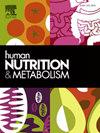Resting metabolic rate (RMR) of recreational female CrossFit® practitioners: Agreement between indirect calorimetry and predictive equations and correlation between RMR ratio and metabolic hormone levels
IF 1.8
Q3 ENDOCRINOLOGY & METABOLISM
引用次数: 0
Abstract
Resting metabolic rate ratio (RMRratio) is calculated dividing the RMR from indirect calorimetry (RMRIC) by the RMR estimate by equations (RMRe). RMRratio is a tool for energy suppression assessment and it can be useful in situations of low energy availability. To date, predictive equations have not been evaluated regarding their agreement with RMR of female CrossFit® practitioners. As such, we aimed to verify the agreement between RMRIC and RMRe and its correlation with metabolic hormones. This was a cross-sectional study with nonprobability sampling. Participants (healthy women aged 18–39 years, with at least 1 year of regular CrossFit® training experience) visited the laboratory once for blood collection and nutritional, body composition, and RMR assessment. RMRIC was estimated using K5; COSMED®. We evaluated its agreement with the RMR estimated by several equations. Then, for each predictive equation, the RMRratio was calculated. We assessed triiodothyronine (TT3), leptin, and insulin-like growth factor (IGF-1) levels. The Bland–Altman method was used to identify the agreement between the RMRIC and the RMRe. Thirty female recreational CrossFit® practitioners (33.11 ± 5.23 y) were assessed. The Cunningham (1980) equation was the one that most agreed with the RMRIC. Still, RMRIC did not differ when compared to TT3 (p = 0.470), leptin (p = 0.848), and IGF-1 (p = 0.634) levels. Likewise, we found no differences when RMRratio was compared by the median and tertiles of hormones. In summary, our findings revealed that the RMRe showed low agreement with the RMRIC. Besides, the RMRratio did not differ according to the hormones TT3, leptin, and IGF-1 of female recreational CrossFit® practitioners.
休闲女性CrossFit®从业者的静息代谢率(RMR):间接量热法与预测方程之间的一致性以及RMR比率与代谢激素水平之间的相关性
静息代谢率比(RMRratio)是用间接量热法(RMRIC)得到的RMR除以方程估计的RMR (RMRe)得到的。RMRratio是一种能量抑制评估的工具,在低能量可用性的情况下非常有用。迄今为止,尚未对预测方程与女性CrossFit®从业者RMR的一致性进行评估。因此,我们旨在验证RMRIC和RMRe之间的一致性及其与代谢激素的相关性。这是一个非概率抽样的横断面研究。参与者(年龄在18-39岁的健康女性,至少有1年的定期CrossFit®训练经验)到实验室进行一次采血、营养、身体成分和RMR评估。RMRIC采用K5估算;cosm®。我们评估了它与几个方程估计的RMR的一致性。然后,对每个预测方程计算RMRratio。我们评估了三碘甲状腺原氨酸(TT3)、瘦素和胰岛素样生长因子(IGF-1)水平。使用Bland-Altman方法来识别RMRIC和RMRe之间的一致性。30名女性休闲CrossFit®练习者(33.11±5.23 y)被评估。Cunningham(1980)方程是最符合RMRIC的方程。然而,与TT3 (p = 0.470)、瘦素(p = 0.848)和IGF-1 (p = 0.634)水平相比,RMRIC没有差异。同样,当RMRratio通过激素的中位数和位数进行比较时,我们发现没有差异。总之,我们的研究结果显示RMRe与RMRIC的一致性较低。此外,RMRratio在女性休闲CrossFit®练习者的激素TT3、瘦素和IGF-1方面没有差异。
本文章由计算机程序翻译,如有差异,请以英文原文为准。
求助全文
约1分钟内获得全文
求助全文
来源期刊

Human Nutrition and Metabolism
Agricultural and Biological Sciences-Food Science
CiteScore
1.50
自引率
0.00%
发文量
30
审稿时长
188 days
 求助内容:
求助内容: 应助结果提醒方式:
应助结果提醒方式:


